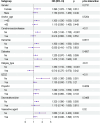Association between the geriatric nutritional risk index and postoperative delirium in gastric surgery patients: an analysis of the MIMIC-IV database
- PMID: 39731004
- PMCID: PMC11673328
- DOI: 10.1186/s12871-024-02874-2
Association between the geriatric nutritional risk index and postoperative delirium in gastric surgery patients: an analysis of the MIMIC-IV database
Abstract
Background: This study explores the correlation between nutritional status, as determined by the Geriatric Nutritional Risk Index (GNRI), and the incidence of postoperative delirium (POD) in patients undergoing gastric surgery.
Methods: Data were obtained from the MIMIC-IV 2.2 database for patients aged 18 years or older who underwent gastric surgery. Patients were categorized into the malnourished group (GNRI < 98) and the non-malnourished group (GNRI ≥ 98). Multivariable logistic regression was performed to assess the association between GNRI and POD, and various potential confounders were adjusted to ensure the robustness of the results. Non-linear relationships between GNRI and POD risk were evaluated through restricted cubic spline (RCS) analysis. Subgroup analyses were conducted to examine the effect of GNRI on POD across different patient categories, and interactions were calculated. Propensity score matching (PSM) was employed to reduce confounding bias.
Results: The study included a total of 4,818 patients, of whom 1,133 (23.5%) developed POD. Patients with a GNRI < 98 had a significantly higher risk of POD compared with those with a GNRI ≥ 98 (odds ratio (OR): 2.21, 95% confidence interval (CI): 1.93-2.53, p < 0.001). Even after adjustment for relevant confounders, GNRI remained significantly associated with POD (OR:1.24, 95% CI: 1.04-1.48, p < 0.001). This association was further supported by the results from PSM (OR:1.23, 95% CI: 1.01-1.51, p = 0.045). RCS analysis demonstrated a non-linear relationship between GNRI and POD risk (p < 0.05). Subgroup analyses revealed significant interactions within the cardiovascular disease, renal replacement therapy, benzodiazepine medication, and vasoactive drug subgroups (p for interaction < 0.05). After the patient population was adjusted to individuals aged 65 and older, this correlation remained significant (p for interaction < 0.05).
Conclusions: This study identifies a significant association between GNRI and the incidence of POD in patients undergoing gastric surgery. Improving nutritional status before surgery may lower the risk of developing POD.
Keywords: GNRI; Gastric surgery; MIMIC-IV database; Nutritional status; Postoperative delirium.
© 2024. The Author(s).
Conflict of interest statement
Declarations. Consent for publication: Not applicable. Competing interests: The authors declare no competing interests.
Figures



Similar articles
-
Geriatric Nutritional Risk Index can predict postoperative delirium and hospital length of stay in elderly patients undergoing non-cardiac surgery.Geriatr Gerontol Int. 2020 Aug;20(8):759-764. doi: 10.1111/ggi.13963. Epub 2020 Jun 22. Geriatr Gerontol Int. 2020. PMID: 32570290 Free PMC article.
-
The geriatric nutrition risk index versus the mini-nutritional assessment short form in predicting postoperative delirium and hospital length of stay among older non-cardiac surgical patients: a prospective cohort study.BMC Geriatr. 2020 Mar 17;20(1):107. doi: 10.1186/s12877-020-1501-8. BMC Geriatr. 2020. PMID: 32183760 Free PMC article.
-
Predictive value of the geriatric nutrition risk index for postoperative delirium in elderly patients undergoing cardiac surgery.CNS Neurosci Ther. 2024 Feb;30(2):e14343. doi: 10.1111/cns.14343. Epub 2023 Jul 5. CNS Neurosci Ther. 2024. PMID: 37408469 Free PMC article.
-
Geriatric nutritional risk index predicts postoperative delirium in elderly: A meta-analysis.Saudi Med J. 2024 Aug;45(9):869-875. doi: 10.15537/smj.2024.45.9.20240216. Saudi Med J. 2024. PMID: 39218460 Free PMC article. Review.
-
Intra-operative blood transfusions raise the risk of postoperative delirium and impede functional recovery in elderly hip fracture patients: a propensity score-matched study.J Orthop Traumatol. 2025 Feb 28;26(1):12. doi: 10.1186/s10195-025-00825-2. J Orthop Traumatol. 2025. PMID: 40021592 Free PMC article. Review.
Cited by
-
Usefulness of the Geriatric Nutritional Risk Index (GNRI) as a Predictor of Postoperative Complications After Colorectal Cancer Surgery.Cureus. 2025 Jun 18;17(6):e86268. doi: 10.7759/cureus.86268. eCollection 2025 Jun. Cureus. 2025. PMID: 40688986 Free PMC article.
-
Preoperative geriatric nutritional risk index as a predictor of postoperative delirium in revision arthroplasty: a 10-year retrospective cohort study.Front Med (Lausanne). 2025 Jul 16;12:1626383. doi: 10.3389/fmed.2025.1626383. eCollection 2025. Front Med (Lausanne). 2025. PMID: 40740942 Free PMC article.
References
-
- Yan E, Veitch M, Saripella A, Alhamdah Y, Butris N, Tang-Wai DF, Tartaglia MC, Nagappa M, Englesakis M, He D, et al. Association between postoperative delirium and adverse outcomes in older surgical patients: a systematic review and meta-analysis. J Clin Anesth. 2023;90:111221. - PubMed
-
- Aldecoa C, Bettelli G, Bilotta F, Sanders RD, Aceto P, Audisio R, Cherubini A, Cunningham C, Dabrowski W, Forookhi A et al. Update of the European Society of Anaesthesiology and Intensive Care Medicine evidence-based and consensus-based guideline on postoperative delirium in adult patients. Eur J Anaesthesiol 2024, 41(2). - PMC - PubMed
MeSH terms
LinkOut - more resources
Full Text Sources
Medical
Miscellaneous

